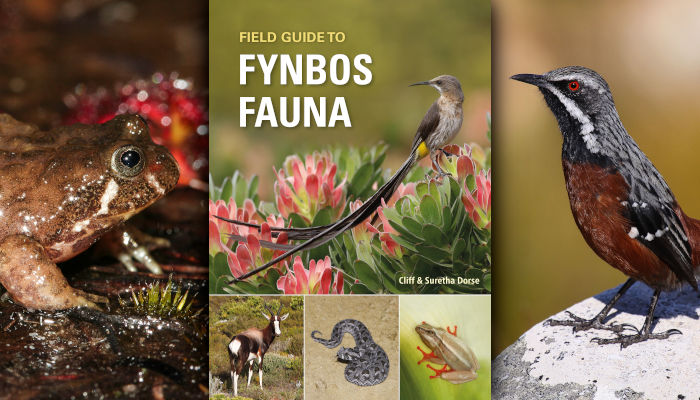Explore the enchanting world of elusive Fynbos creatures with Field Guide to Fynbos Fauna
More about the book!

Cliff and Suretha Dorse, dedicated conservation biologists, share their two-decade exploration of the Fynbos Biome in their book, Field Guide to Fynbos Fauna.
The guide celebrates rare encounters with elusive creatures and highlights the rich biodiversity of this beloved biome, enriched by the authors’ interactions with fellow nature enthusiasts.
‘Some species are ecosystem engineers and others are essential predators keeping the numbers of prey species in check.’
The Cape Floristic Region (CFR) has long been recognised as being completely unique and special on a global scale. Notably, this global recognition includes Unesco World Heritage Site status and Global Biodiversity Hotspot status assigned by Conservation International. The Fynbos Biome forms a distinctive and well-defined area at the south-western tip of Africa, and is one of the four biomes that make up the greater CFR. With over 9000 plant species, the biome is primarily known for its amazing floral diversity and endemism. It is however also home to a remarkable array of highly specialised and charismatic fauna that are largely overlooked.
One can spend a full day in Mountain Fynbos and see relatively few animals. This is partly due to the fact that the majority of species are shy and/or nocturnal. As a result, one may be forgiven in thinking that animals are not an important feature in this botanical wonderland.
There is, however, a wealth of extremely interesting and enigmatic fauna in these ecosystems. This faunal component fulfils vital ecological functions, including critical pollination and seed dispersal rolls. Some species are ecosystem engineers and others are essential predators keeping the numbers of prey species in check.
For those unfamiliar with these special animals, you can look forward to becoming acquainted with the spectacular Spectacled Dormouse (Graphiurus ocularis), the cryptic Montane Marsh Frog (Poyntonia paludicola), the elegant Black Girdled Lizard (Cordylus niger) and the charming Cape Rockjumper (Chaetops frenatus), to name a few.
There is an impressive array of field guides and reference books devoted to the flora of the Fynbos, yet no dedicated fauna guide for the region. While there are excellent field guides for snakes, frogs, mammals and birds, these focus on southern Africa as a whole and are rather large volumes. It is not always practical to acquire all of these, and it is certainly not feasible to carry all of these volumes into the field.
Fynbos Fauna is a concise collection of 420 species of fauna. This includes 91 mammals, 54 frogs, 113 reptiles and 162 birds that occur in the Fynbos, Renosterveld and Strandveld ecosystems that comprise the Fynbos Biome. This focused guide can be slipped into the backpack of anyone out and about in the biome. It has been written to appeal to both the interested amateur and the dedicated naturalist.
The hope is that this resource will be of value to a wide range of readers, while fostering additional awareness and passion for the spectacular Fynbos Biome and the critters that call it home.
- Field Guide to Fynbos Fauna is out now from Penguin Random House SA!
Also available:
Field Guide to Fynbos
by John Manning
Featuring over 1,000 species from the Cape Floristic Region, home to one of the world’s richest floras, this fully updated edition focuses on the most common and ‘showy’ plants. An introduction unpacks the world of fynbos – including origins, diversity, climate and adaptations – and is followed by a photographic key and descriptions of the fynbos families. Species descriptions are accompanied by photographs, distribution maps, comparisons with similar species, and notes on traditional uses. An indispensable guide to South Africa’s most renowned flora for botanists and amateurs alike.
Ericas of the Fynbos
by John Manning & Nick Helme
Ericas of the Fynbos introduces 170 common species from the Cape Floristic region’s rich array of 760 Ericas. This guide aids identification with detailed descriptions, key features, distribution info, and vibrant photos. Tackling the challenge of telling these delicate flowers apart, the book offers insights into biology, pollination, and distribution. Its lively design enhances the experience, empowering flower enthusiasts, gardeners, and hikers to confidently identify ericas in the wild, celebrating their stunning diversity and beauty.
Pocket Guide Fynbos
by John Manning
A comprehensive handbook showcasing 300+ spectacular and commonly found species from South Africa’s famed floral kingdom. With detailed entries, vibrant photos, and distribution maps, it offers succinct plant descriptions, habitat insights, and comparisons. The guide’s floral key aids accurate identification, while 10 distinct species groups enhance usability. The introduction delves into the world of fynbos, covering origins, diversity, adaptations, and conservation. A must-have for those captivated by South Africa’s remarkable floral wonders, this compact guide provides invaluable assistance in exploring the diverse flora.
Categories Lifestyle Non-fiction South Africa
Tags Cliff Dorse Field Guide to Fynbos Fauna New books New releases Penguin Random House SA Struik Nature Suretha Dorse The Penguin Post
